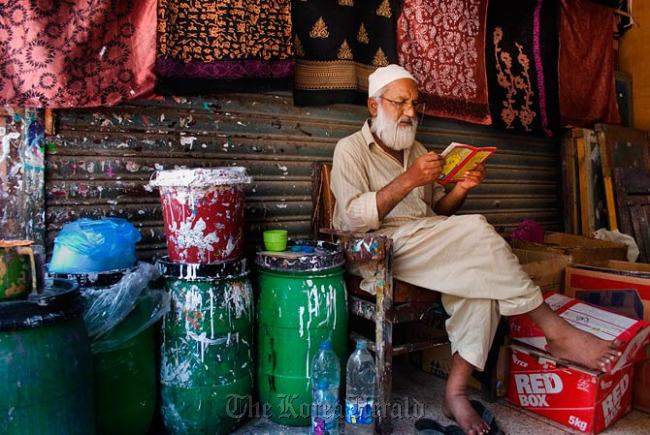Pakistani women celebrate color, style and fashion as much as they do Eid, Muslims’ biggest festival.
And Eid celebrations brought with them colorful clothes of all kinds, from the flow of chiffon dupattas (long scarf) to the elegance of silk kameezes (long shirt or tunic).
As with fashion in Pakistan, there are trends that come and go yet some are timeless ― block printing is one such trend, and in recent years, screen printing too has become mainstream fashion.
There are quite a few designers and stores that provide block printing and screen printing services to Karachi’s clientele.
 |
An employee at the block print shop sits next to barrels of dye used in the printing process. (Dawn) |
The most popular of these shops is housed in a surprisingly spacious back gali (alley) of Karachi, a well-known store that has been providing women with some creative block and screen prints for the last twenty years.
Twenty years, however, is just a dot on the timeline of this fiber art.
Block and screen printing both have their origins in East Asia with the earliest block printing device dating back to the year 220 in Ancient China.
Block printing was used for printing on cloth and paper both as a form of printing books, images and designs for linens. Screen printing was invented about 800 years later, also in Ancient China, and introduced to the world around the late 18th century.
In Pakistan, signs of block printing date back to the Indus civilization, where the famous Sindhi ajrak is printed. In modern day India, block printing traces its roots to Gujrat and Rajasthan. This method since its creation in China, moved west through the Indian subcontinent, finally reaching Europe and becoming a developed industry, especially in Germany. In Britain, the artist William Morris’s block print designs are still popular today.
Block printing technique is often executed as it was 4,000 years ago.
Although dyes, types of cloths and designs may have changed, the carving of the wooden block and process of stamping roughly remains the same in some Pakistani and Indian regions.
The craft of intricate block carving in Pakistan is slowly dying, said a block maker from Hala, who visits Karachi to sell his designs.
There are fewer and fewer craftsmen in Pakistan who make traditional designs as modern patterns inundate the market. The block maker said his designs would only sell for about 2,000 rupees ($21.11) to 3,000 rupees whereas the making of the block takes him more than a week.
The owner of the block printing shop in Karachi explained that he already had artists around Karachi who made more popular designs.
Many designers visit the store, which is also popular with textile students from the Indus Valley School and Iqra University, he said.
Showing a rag lying discarded to the side amongst barrels of color, the owner said he only buys imported dye and paint as Pakistani materials don’t make the cut anymore.
Screen printing, on the other hand, is a relatively newer form of “fiber art.” Its takeoff as a mainstream tool for fabric printing was a slow one, until silk mesh became more widely available in the world.
Today, it has become more popular in Pakistan as compared with block printing, explained the store owner, saying that it allows for versatility in design.
Screen printing is popular, amongst many reasons, for its flexibility in the different paints and dyes, which can be used on the same mesh.
Multiple colors can be used in a screen print but usually more than one frame is utilized.
In modern Western culture, screen printing is popular in the underground scene and, with many subcultures, it has a do-it-yourself culture associated with it. Artist Andy Warhol popularized the technique in the late 60’s with his now widely printed silk screen painting of American actress Marilyn Monroe.
The way fashion is getting popular in Pakistan shows it would get a following for decades to come as there is always a large group of clientele in the country keen about the ancient craft.
By Sara Faruqi
(Dawn)








